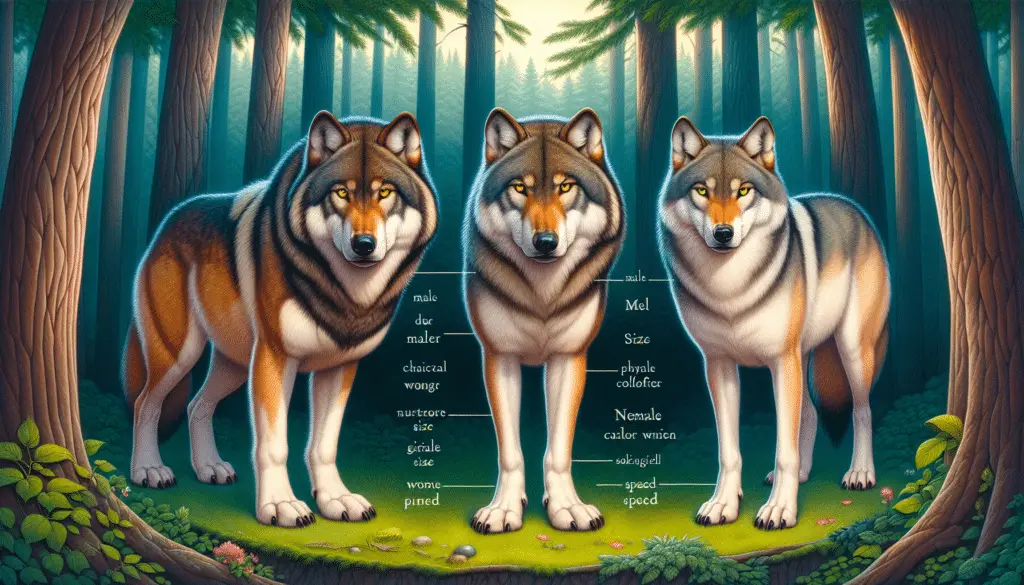Differences in Physical Appearance
Table of Contents
ToggleWhen comparing male and female wolves, one of the most noticeable differences lies in their physical appearance. Male wolves generally have a larger and more robust build compared to their female counterparts. This size difference is significant, as it directly impacts their roles within the pack.
A typical adult male wolf can weigh between 80 to 100 pounds, whereas a female wolf usually weighs between 60 to 80 pounds. The variance in weight can also be attributed to the subspecies of the wolf, as some can weigh more or less depending on their geographical location.
Males often have broader heads and thicker necks, which are not only vital for their hunting capabilities but also for asserting dominance within the pack. Their larger size is advantageous in hunts, especially when taking down large prey such as elk or deer.
Female wolves, on the other hand, have a more slender and graceful appearance. Their smaller size allows them to be more agile and quick, which is essential for various tasks within the pack.
Behavioral Differences
The roles and behavior of male and female wolves within the pack also differ significantly. In a wolf pack, males usually take on the role of alpha, the dominant leader responsible for making decisions, protecting the pack, and leading hunts. While the alpha male is the primary leader, the alpha female plays a crucial role in maintaining the pack’s social structure and nurturing its members.
Male wolves are more likely to exhibit aggressive behaviors, which are essential for establishing and maintaining dominance. They engage in displays of strength and sometimes fights to assert their position within the pack.
Female wolves, in contrast, tend to be more nurturing and caring. They are the primary caregivers for the pups, playing a significant role in their upbringing and education. The alpha female often makes decisions regarding the care and upbringing of the young, while also providing support to the alpha male.
Interestingly, it is common for gray wolves to form lifelong monogamous pairs. This strong bonding between the alpha male and alpha female helps ensure the stability and strength of the pack.
Reproductive Role and Breeding
The differences between male and female wolves become even more apparent when examining their reproductive roles. In a wolf pack, only the alpha pair typically breeds, which helps control population growth and ensures the survival of the fittest genes within the pack.
Female wolves generally have one litter per year, with the breeding season occurring in late winter. After a gestation period of about 63 days, the female gives birth to a litter of four to six pups.
During the birthing process, the female retreats to a den, often prepared months in advance. Once the pups are born, she remains secluded in the den for several weeks, nursing and caring for her young. The male plays a supporting role during this time, hunting for food and protecting the den site.
Male wolves also take part in the upbringing of the pups, once they are strong enough to leave the den and explore the surroundings. This shared responsibility helps ensure the survival and health of the young wolves.
Communication Differences
Wolves rely heavily on vocalizations, body language, and scent marking for communication within the pack. While both male and female wolves use these methods, there are subtle differences in how they communicate.
Male wolves often have deeper and more resonant howls, which serve to establish territory and communicate with other males. These howls can be heard over long distances, helping to coordinate pack movements during hunts and warn other packs to stay away from their territory.
Female wolves have higher-pitched howls and often use whines and whimpers to communicate with their pups. This softer communication is essential for nurturing and guiding the pups during their early stages of development.
Hunting Strategies
The hunting strategies of male and female wolves complement each other and contribute to the pack’s overall success. Male wolves, with their larger size and strength, often take on the role of chasing and cornering larger prey such as deer or elk. They use their size to their advantage, isolating the weakest member of a herd for an easier kill.
Female wolves, with their agility and speed, play a significant role in flanking and directing the prey towards the males. This coordinated effort between males and females ensures a higher success rate in hunts and provides enough food for the entire pack.
It is fascinating to observe Ethiopian wolves, known for their unique hunting techniques, where both males and females work together to catch rodents, which are their primary source of food.
Territorial Behavior
Both male and female wolves are highly territorial, but their roles in marking and defending territory differ. Male wolves are more likely to engage in scent marking and vocalizations to establish and protect their territory. This behavior helps to deter rival packs and ensure control over a specific area.
Female wolves, while also participating in scent marking, are more focused on protecting the den site and ensuring the safety of the pups. They are less likely to engage in territorial disputes but will fiercely defend their young if threatened.
This division of labor within the pack ensures that both the territory and the den site are well-protected, allowing the pack to thrive in its environment.
Frequently Asked Questions About Wolves
What is the average lifespan of a wild wolf?
In the wild, wolves typically live to be about 6 to 8 years old.
Do wolves mate for life?
Yes, wolves often form lifelong monogamous pairs.
How far can a wolf’s howl be heard?
A wolf’s howl can be heard up to 10 miles away under optimal conditions.
What do wolves primarily eat?
Wolves primarily hunt large ungulates like deer, moose, and elk.
Are wolves dangerous to humans?
Wolves are generally not dangerous to humans and tend to avoid contact.
How fast can wolves run?
Wolves can run at speeds of up to 35 miles per hour.
What are some common wolf subspecies found in North America?
Common subspecies in North America include the gray wolf and the Mexican wolf.
What is the primary role of the alpha pair in a wolf pack?
The alpha pair leads the pack, makes decisions, and is typically the only breeding pair.
Do wolves have any natural predators?
Wolves’ natural predators include bears, mountain lions, and humans.
How do wolves care for their young?
The alpha female primarily cares for the pups, with help from the alpha male and other pack members.
Wolves’ Adaptability and Survival Instincts
Wolves are highly adaptable creatures, capable of thriving in diverse environments. From the freezing tundra to the dense forests, the species’ wide distribution demonstrates its survival capabilities. What sets wolves apart is their ability to adjust their behaviors and strategies according to habitat and available resources. This adaptability is crucial for their survival.
For example, Arctic wolves endure harsh climates by forming small packs that can efficiently hunt in such an extreme environment. The smaller pack size makes it easier to manage food resources, ensuring survival during scarce periods. On the other hand, gray wolves in more temperate regions may form larger packs to efficiently hunt larger prey, such as deer or elk.
This flexibility extends to their diet as well. Wolves are opportunistic feeders, consuming a range of animals from small rodents to large ungulates. This diet variation is essential for their survival, especially in habitats where prey availability fluctuates.
Wolves and Their Role in Ecosystems
Wolves play a crucial role in maintaining the balance of ecosystems. By preying on larger herbivores like deer, they help regulate these populations, preventing overgrazing and ensuring the health of vegetation. This action promotes biodiversity and helps other species thrive.
For example, the reintroduction of wolves in Yellowstone National Park in the 1990s led to a phenomenon known as a trophic cascade. As wolf numbers increased, the elk population decreased, allowing willow and aspen trees to grow. This growth provided habitats for birds and stabilized riverbanks, thereby improving the overall health of the ecosystem.
Wolves also contribute to scavenger communities. The remains of their kills provide food for other animals like bears, birds, and even insects. In this way, wolves indirectly support various species within their habitats.
Challenges and Conservation Efforts
Despite their adaptability, wolves face numerous challenges that threaten their survival. Human activities such as urbanization, deforestation, and hunting have significantly impacted wolf populations.
In many regions, wolves are still persecuted due to conflicts with livestock owners, leading to efforts to control their numbers through culling or hunting. These actions often disrupt pack structures and can lead to a decline in wolf populations.
Conservation efforts are crucial to ensure the long-term survival of wolves. Various organizations and governments are working to establish protected areas, promote coexistence with humans, and mitigate conflicts through compensation schemes for livestock losses.
One notable success story is the conservation of the Mexican wolf, which was once on the brink of extinction. Through concerted efforts including captive breeding and reintroduction programs, the species has shown signs of recovery. These initiatives highlight the importance of collaborative conservation efforts in preserving these apex predators.
How Wolves Interact With Other Predators
Wolves are not the only apex predators in their ecosystems, and their interactions with other predators can be complex. In regions where they coexist with bears, mountain lions, or coyotes, competition for food resources is inevitable.
Studies have shown that wolves often dominate over smaller predators like coyotes, effectively regulating their populations. This interaction benefits ecosystems by preventing smaller predator populations from becoming too large and potentially decimating prey species.
However, wolves may avoid direct confrontations with larger predators like bears, which can overpower them. Instead, wolves use their pack structure and cooperative hunting strategies to compete effectively for resources.
These interactions highlight the intricate balance of predator-prey dynamics and the crucial role wolves play in their ecosystems.
Wolves and Their Historical Significance
Wolves have held a significant place in human history and culture for centuries. They are often featured in folklore, mythology, and literature, symbolizing various attributes like strength, loyalty, and cunning.
In many Indigenous cultures, wolves are revered as spiritual animals, often seen as teachers and guides. For example, in Native American cultures, the wolf is considered a symbol of courage, resourcefulness, and familial loyalty.
This deep cultural significance underscores the importance of preserving wolves, not just for ecological reasons but also for their cultural heritage. Understanding and respecting this heritage can foster more meaningful conservation efforts and promote coexistence between humans and wolves.
Next Steps for Wolf Conservation
The future of wolf conservation involves addressing both ecological and social challenges. Educating the public about the ecological benefits of wolves and promoting coexistence through effective conflict mitigation strategies are essential steps.
In addition, ongoing research is crucial to better understand wolf behavior, genetics, and interactions with ecosystems. This knowledge can inform adaptive management strategies and help improve conservation outcomes.
Collaborative efforts involving governments, conservation organizations, scientists, and local communities will be key to ensuring the survival and thriving of wolf populations worldwide.



